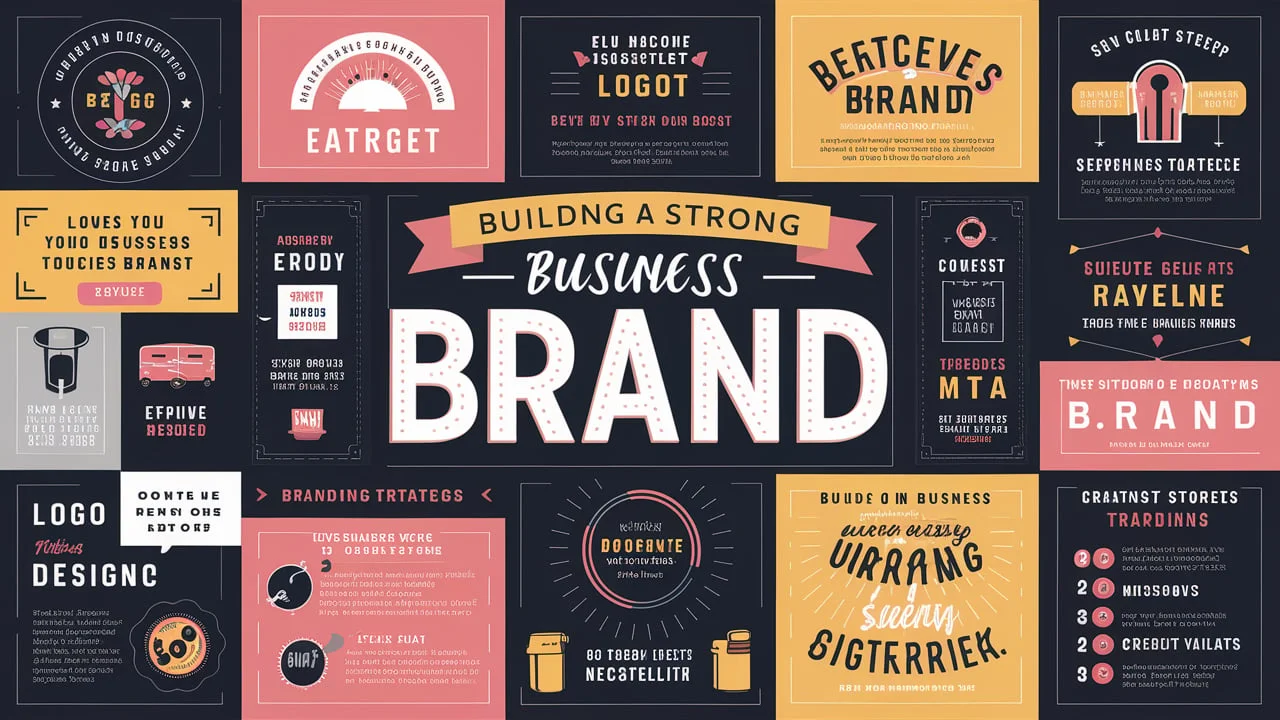Building a strong business brand is essential for establishing a unique identity, gaining customer trust, and standing out in a competitive market. Here’s a comprehensive guide on how to build a strong business brand:
1. Define Your Brand Identity
- Mission and Values: Clarify your company’s mission and core values that define its purpose and principles.
- Brand Personality: Determine the personality traits and characteristics that you want your brand to embody, reflecting its identity and voice.
2. Understand Your Target Audience
- Market Research: Conduct thorough research to identify your target demographic, their needs, preferences, and behaviors.
- Customer Insights: Gain insights into what motivates your customers’ purchasing decisions and how your brand can meet their expectations.
3. Develop a Unique Value Proposition (UVP)
- Differentiation: Define what sets your brand apart from competitors and articulate it clearly to your audience.
- Benefits: Communicate the unique benefits and value that customers will experience by choosing your products or services.
4. Create Consistent Branding Elements
- Logo and Visual Identity: Design a memorable logo and consistent visual elements (colors, fonts, imagery) that represent your brand.
- Brand Guidelines: Establish clear guidelines for how your brand should be portrayed across all channels and communications.
5. Craft Compelling Brand Messaging
- Brand Storytelling: Develop a compelling narrative that communicates your brand’s history, values, and mission in a way that resonates with your audience.
- Tagline: Create a memorable tagline or slogan that encapsulates your brand’s essence and value proposition.
6. Build Brand Awareness
- Content Marketing: Create valuable and engaging content that showcases your expertise and reinforces your brand’s values.
- Social Media Presence: Use social media platforms strategically to connect with your audience, share your brand story, and build relationships.
7. Foster Brand Loyalty
- Consistent Experience: Ensure consistency in customer interactions, from product quality to customer service, to build trust and loyalty.
- Customer Engagement: Engage with customers regularly through feedback, personalized communications, and loyalty programs.
8. Leverage Influencers and Advocates
- Brand Ambassadors: Collaborate with influencers or brand advocates who align with your values and can amplify your brand message to their followers.
- Customer Advocacy: Encourage satisfied customers to become advocates who promote your brand through reviews, referrals, and testimonials.
9. Monitor and Adapt
- Brand Monitoring: Monitor online conversations, reviews, and feedback to gauge brand perception and identify opportunities for improvement.
- Adaptation: Stay responsive to market trends, customer feedback, and changes in the competitive landscape to evolve your brand strategy as needed.
10. Measure Brand Success
- Key Performance Indicators (KPIs): Define metrics such as brand awareness, brand sentiment, customer loyalty, and market share to track the effectiveness of your brand-building efforts.
- Feedback and Analysis: Regularly analyze data and feedback to assess the impact of your branding initiatives and make data-driven adjustments.
Example of Strong Business Brand Building
- Nike: Known for its “Just Do It” slogan and iconic swoosh logo, Nike has built a strong brand around athleticism, innovation, and empowerment. Through strategic partnerships with athletes and impactful marketing campaigns, Nike has established itself as a global leader in sportswear and athletic gear.
Welcome to the dynamic world of business, where every entrepreneur and small business owner strives to carve out their niche amidst fierce competition. In this fast-paced environment, one key element reigns supreme: a strong business brand. As we delve into the intricacies of unlocking secrets to building a robust brand, it becomes evident that understanding its significance is not just beneficial—it’s imperative for success.
Picture this: your brand is more than just a logo or a name; it’s the very essence of your business, setting the stage for recognition and loyalty in a crowded marketplace. By comprehending the transformative power of branding, entrepreneurs can unlock untapped potential and amplify their impact globally.
How does branding differentiate your company from others? It’s not merely about what you sell but how you connect emotionally with your audience, forging lasting relationships that transcend transactions. Join us on this enlightening journey as we uncover actionable strategies and insights to elevate your brand presence—and watch as possibilities unfold beyond horizons previously unexplored.
The Power of Branding.
Branding stands as the beating heart of any business, regardless of its scale. It transcends mere aesthetics or logos; it embodies the essence of a company’s identity and creates a lasting impression in the minds of consumers.
Consider the global giant Coca-Cola—its iconic red-and-white logo is instantly recognizable worldwide, a testament to the power of strong branding. By investing in developing a unique brand voice, businesses can carve out their distinct place in the market landscape.
A robust brand not only sets you apart from competitors but also serves as a magnetic force, drawing customers towards your offerings. Take Apple, for instance; beyond their innovative products, it is Apple’s carefully crafted brand image that defines them—an embodiment of sleek design coupled with cutting-edge technology.
This amalgamation fosters an emotional connection with consumers who align themselves with what the brand represents—a lifestyle choice rather than just a purchase decision.
Effective branding speaks to consumers on a deeper level, tapping into their emotions and values. Nike’s timeless “Just Do It” slogan encapsulates empowerment and resilience—a message that resonates with athletes worldwide. This emotional bond nurtured through branding cultivates loyalty and trust among customers.
When consumers feel connected to a brand not just rationally but emotionally, they become advocates who champion the brand through word-of-mouth referrals and unwavering support—the ultimate goal for any business looking to thrive amidst fierce competition.
Crafting Your Brand Identity.
Crafting a strong brand identity is like giving your business a personality that customers can connect with on a deeper level. One of the first steps in this process is defining your brand’s unique values, mission, and vision.
For instance, Patagonia has built its brand identity around environmental sustainability and ethical practices. This commitment to their values not only resonates with their target audience but also sets them apart from competitors who may focus solely on profit margins.
Creating a compelling brand story is another important aspect of building your brand identity. Consider the success story of TOMS shoes, whose simple yet powerful narrative about giving back through their “One for One” model captured the hearts of consumers worldwide. By weaving a story that evokes emotion and purpose into your brand, you establish a connection that goes beyond products or services.
Visual elements play a crucial role in solidifying your brand identity. Take, for example, Coca-Cola’s iconic red and white color scheme and timeless logo. These visual cues instantly evoke feelings of nostalgia and refreshment in consumers’ minds. When establishing your own visual elements, ensure they are consistent across all platforms to create a cohesive brand image that customers can easily recognize and remember.
In conclusion, crafting a strong brand identity requires aligning your values with your mission, telling a compelling story that resonates with your audience’s emotions, and creating visual elements that embody your brand essence.
By focusing on these key components, you can build a brand identity that not only differentiates you from competitors but also fosters loyalty and trust among customers who share your values and vision.
Building Trust and Credibility.
One of the cornerstones of a strong business brand is trust. Leveraging customer testimonials and reviews can significantly impact how your brand is perceived by potential customers. When potential clients see positive feedback from satisfied customers, it creates a sense of reliability and credibility around your brand.
For example, a small business specializing in handmade jewelry could showcase glowing reviews from repeat customers who rave about not just the product quality but also the exceptional customer service they received.
Transparency and authenticity play pivotal roles in establishing credibility for any brand. Being transparent about your business practices, values, and processes builds trust with consumers who value honesty.
Consider the success story of a sustainable fashion brand that openly shares its supply chain process on social media, demonstrating commitment to ethical practices. This level of transparency fosters trust among environmentally conscious consumers who appreciate authentic brands.
Consistent messaging across all touchpoints is crucial in reinforcing trustworthiness and credibility. Whether through your website, social media channels, or advertising campaigns, maintaining a unified voice and brand image helps customers recognize and remember your brand easily.
Imagine a tech startup that consistently conveys its dedication to innovation and user-centric design in every communication; such coherence reinforces the company’s commitment to excellence. By ensuring consistency in messaging, you show customers that they can rely on your brand to deliver what it promises.
Social Media Strategies for Brand Building.
In today’s digital age, leveraging social media is paramount for building a strong business brand. Platforms like Facebook, Instagram, and Twitter offer unparalleled opportunities to enhance brand visibility and engage with a global audience.
By strategically utilizing these channels, businesses can create meaningful connections with customers and drive brand loyalty. For instance, an artisanal coffee company could showcase behind-the-scenes footage of their brewing process on Instagram Stories, allowing followers to feel a part of the brand journey.
Engaging with customers through interactive content is key to fostering relationships and creating brand advocates. Implementing polls, quizzes, or live Q&A sessions can spark conversations and generate authentic engagement.
Consider the example of a skincare brand launching a virtual skincare consultation service on Facebook Live – this not only educates customers but also showcases the brand’s expertise and commitment to personalized care.
Furthermore, using analytics tools to track social media performance provides invaluable insights into what resonates with your audience. Understanding metrics such as engagement rates, reach, and conversions allows businesses to refine their strategies effectively.
For instance, a fashion retailer may use data analytics to discover that posts featuring user-generated content receive higher engagement rates, prompting them to incorporate more customer photos in their social media campaigns.
By harnessing social media’s power through interactive content creation and data-driven optimization, businesses can establish a robust online presence and cultivate lasting relationships with their target audience. In today’s competitive landscape, brands that actively engage with consumers on these platforms gain a significant edge in building trust and loyalty that transcends borders.
Global Brand Expansion.
Expanding a brand globally comes with unique challenges and opportunities. Adapting your branding strategy for international markets is crucial for resonating with diverse audiences while maintaining the essence of your core values.
For instance, when Starbucks entered China, a culture known for tea-drinking traditions, they successfully localized their menu to include beverages like green tea lattes to cater to local preferences without compromising their global identity as a coffee giant. This kind of thoughtful adaptation showcases the importance of understanding cultural nuances when expanding into new territories.
Overcoming cultural barriers through localized marketing efforts is key to gaining acceptance and trust in new markets. One prime example is Coca-Cola, which has mastered the art of tailoring their campaigns to fit regional sensitivities.
In countries like Japan, where gift-giving holds high significance, Coca-Cola launched personalized bottle labels during special occasions, showcasing their awareness and respect for local customs. By integrating these cultural elements into their marketing strategies, they were able to connect authentically with consumers in diverse regions, fostering brand loyalty on a global scale.
Collaborating with local influencers or partners can be a strategic move to boost brand awareness on an international level. Brands like Nike have excelled in this aspect by partnering with athletes worldwide who embody their values and resonate with local audiences.
Serena Williams‘ collaboration with Nike transcends boundaries by inspiring female empowerment globally while also respecting cultural diversity. Such partnerships not only enhance brand visibility but also create meaningful connections that transcend geographical borders, reinforcing the brand’s impact on a global scale.
The synergy between global brands and local influencers or partners can bridge cultural gaps and facilitate deeper engagement with consumers around the world.
Measuring Success: Key Metrics for Brand Performance.
To ensure your brand is on the right track and resonating with your target audience, it’s crucial to identify the Key Performance Indicators (KPIs) that will allow you to gauge the effectiveness of your branding efforts.
These KPIs serve as signposts along the journey toward establishing a strong business brand. Metrics such as brand awareness, customer loyalty, and market share growth can provide valuable insights into how well your brand is performing in the market.
Tracking brand awareness metrics allows you to understand how recognizable and familiar your brand is to consumers. By analyzing data on reach, impressions, and engagement across various platforms, you can gauge the impact of your branding initiatives and adjust strategies accordingly.
Customer loyalty metrics, on the other hand, delve into customer satisfaction levels, repeat purchase behavior, and advocacy for your brand. Monitoring these metrics provides a holistic view of how well your brand is building enduring relationships with customers.
Market share growth serves as a barometer for your brand’s competitiveness within its industry. By monitoring market share data over time and comparing it to competitors, you can assess whether your branding efforts are translating into tangible business results.
Leveraging data-driven insights from these key metrics arms you with the information needed to make informed decisions about refining and enhancing your brand strategy moving forward. Continuous analysis and optimization based on these metrics are essential for staying ahead in today’s dynamic business landscape.
Empowering Your Brand: Elevating Businesses Through Strategic Branding.
Congratulations on embarking on the journey to build a strong business brand that resonates with your audience! As you’ve discovered throughout this article, the power of branding goes far beyond just a logo or color scheme. It’s about creating meaningful connections, building trust, and standing out in a crowded marketplace.
By crafting a compelling brand identity that reflects your values, mission, and vision, you’re laying the foundation for long-term success. Each step you take to engage with customers authentically, harness the potential of social media, adapt to global markets while staying true to your core values, and measure your performance through key metrics brings you closer to achieving your branding goals. Remember, every interaction with your brand is an opportunity to reinforce trust and credibility.
As you move forward with implementing the actionable strategies outlined in this guide, keep in mind that building a strong business brand is not just about aesthetics—it’s about storytelling, emotional connection, and delivering value consistently.
Stay optimistic about the possibilities that lie ahead as you empower your business through strong branding efforts. Your unique story has the potential to resonate globally and make a lasting impact on your audience. Embrace the journey ahead with confidence and enthusiasm – your brand’s success awaits!
Conclusion
Building a strong business brand requires a strategic and cohesive approach that aligns your brand identity with customer expectations, fosters loyalty, and differentiates you from competitors. By defining your brand identity, understanding your audience, creating consistent branding elements, and engaging effectively with customers, you can build a resilient brand that resonates with your target market and drives long-term success.
As an author writing and creating business courses and articles, I am responsible for developing and delivering high-quality content that is informative, engaging, and relevant to the target audience.
I monitor and analyzes business trends and topics to create courses and articles that provide value to readers and students here. I am responsible for ensuring that all content is accurate, well-written, and met the needs of the target audience.






